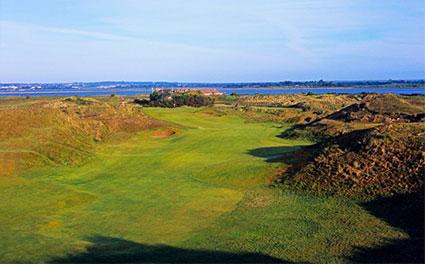Most foreign golfers who come to Ireland fly into Dublin. That makes sense.
But they spend at most one jet-lagged day in the invigorating capital and then hop on their tour bus for a week in the Southwest at mighty Ballybunion and Lahinch, or perhaps the remote Northwest, with Carne, Rosses Point and the salmon-choked River Moy.
All perfectly smart itineraries, plus Northern Ireland, but the careful connoisseur of Irish golf doesn't flee Dublin so quickly. Within 20 miles of your hotel room -- and sometimes far less -- is a week of extraordinary links golf that has one huge advantage over every other destination.
You're in friggin' Dublin. If you can't find great outdoor cafes, stunning museums (mostly free), luscious parks and brilliant local music here, you're stuck in the car park.
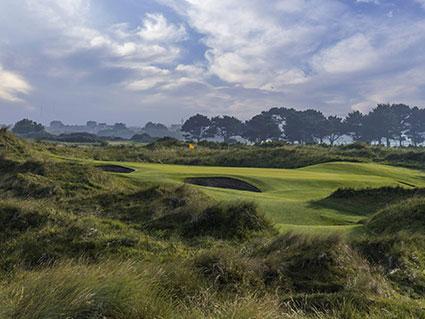
In July, after a typical adventure with American Airlines -- a 24-hour delay from two consecutive equipment failures out of O'Hare, including a radar outage and mid-air u-turn over Canada back to Chicago -- I rediscovered the simple delight of staying put in Dublin, eating well every night, yet never compromising on the quality of golf.
I met up at Portmarnock Hotel & Golf Links, 12 miles north of downtown Dublin, with some golf-writer friends who had just witnessed Jordan Spieth's stunning British Open Sunday at Royal Birkdale.
The stately-but-spry hotel opened in 1996 and sits on a peninsula beside an enjoyable links course that Bernhard Langer originally designed -- with more than 100 bunkers -- but which was extensively tweaked recently by new owners into a more satisfying experience. For example, it's one of the few courses in Ireland with a short-game practice area, and a new elevated first tee allows you to breathe in the gorgeous Velvet Strand, a wide, 5 km long, "Blue Flag" beach.
Do not confuse this young upstart course with the most holy Portmarnock Golf Club, founded 1894, just down the road. But the youthful man-made course, at 7,000 yards from the tips, is a lovely first stop, with all the wispy seaside fescues you were expecting. And if you're staying at the hotel, the tee boxes are literally just outside your door. The green fees are at least half what you'll pay at the magisterial elder, so this is the perfect place to get your links legs and learn to keep the ball low.
The humbling history of Portmarnock Golf Club -- and, yes, it was all-male much too long -- seeps from the walls and the rows of club captain photos. Harry Vardon, Sam Snead, Arnold Palmer, Ben Crenshaw and Seve Balesteros all won here on land that once belonged to John Jameson, of whiskey fame. They've hosted 13 Irish Opens and seemingly every significant European golfer of the past century.
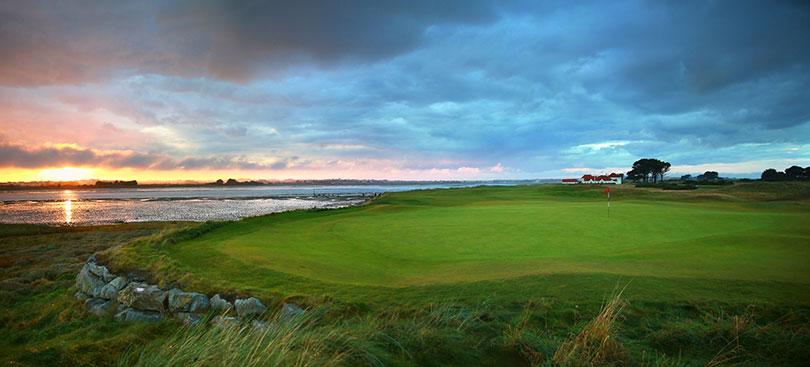
Yet, that's not why you came.
One of the world's great links, Portmarnock has been expertly shaped by the likes of Harry Colt, Harry Cairnes, Eddie Hackett, Fred Hawtree, and more recently, Martin Hawtree, who has remodeled numerous British Open venues, yet its original Scottish founders would recognize it today. It's not novel to say of an Irish links course that a golfer will feel alone amid the dunes and the ocean, but on this windy peninsula along the Irish Sea, the welcome solitude never escapes you.
This course is perennially ranked among the world's top 50, often among the best 15 in Europe, yet its legendary difficulty never seems contrived. The back tees nearly reach 7,400 yards, and only one par-four is under 400 yards, while three par-fives are 603, 565 and 577, yet there are no true blind shots, and the greens aren't overly penal. As with the best Irish courses, its designers never forgot that the sea is test enough.
Some think the best hole may be the 176-yard 15th, which hugs the strand off to the right. Simple and elegant, player-designers such as Crenshaw, Faldo and Norman think it is one of the finest par-threes in the world. I should admit -- heresy alert -- that the first time I played Portmarnock, about five years ago on an unnaturally calm, overcast day with some jet lag, I was slightly underwhelmed. I had been spoiled by the giant dunes out West at places like Enniscrone and Carne, and I just went through the round without appreciating the craftsmanship or subtleties.
I foolishly thought perhaps the times had passed the storied championship links. Hardly. The course remains vibrant and challenging, and virtually every hole is a display of architectural nuance that leaves you in awe of what was done without massive earth-movers.
Not far away, The Island, founded in 1890, is one of those Irish courses that rarely trips off the tongue of swashbuckling Yanks who will play 36 holes before dawn. But its dunes are just that much higher than the Portmarnock pair and Royal Dublin, giving the course a bit more scenic drama.
Stodgy in olden times, The Island once discouraged Catholics, caddies, non-member dogs and tradesmen, but it's now a welcoming contemporary club to all and a masterful pure links that, not coincidentally, also bears the design instincts of Eddie Hackett and Fred Hawtree. (If you happen to stay in Malahide, a tidy seaside village with great walks and wonderful restaurants, you can see The Island just across the estuary, and at low tide, almost walk to it.)
The Island boasts a handful of exceptional holes defined by amphitheaters of marram grasses and gnarly tufted dunes. But more important than memorizing signature holes is the assurance that none of them is disappointing. The Island absolutely belongs beside Ballyliffin, Rosapenna, Enniscrone and a host of great Irish courses that are often overlooked as the tour buses flock to Ballyfamous.
My day at close-by Royal Dublin was enlivened by a three-club wind and the wise counsel of Christy O'Connor, whose father, Christy Sr., a 10-time Ryder Cup member and cherished member of the club, passed away in May 2016.
Our genial host, often called Christy Minor -- not to be confused with O'Connor's nephew, known misleadingly as Christy Jr., who also died last year -- had a deft short game and a piercing ball flight that mocked the breeze. He saved my wretched day with this simplest of advice – don't take the club back too inside. Oh, the fundamentals.
Royal Dublin is about as steeped in history as one can steep. It is the only "Royal" in the Republic and also its oldest chartered golf club, having begun in 1885. Yet, not too long ago, the gilded heritage was not enough to make this beloved track your first stop on the East Coast, but a much-needed reinvigoration of the greens complexes and bunkers by the prolific course-doctor, Martin Hawtree, gave new life to the stately but generally flat landscape.
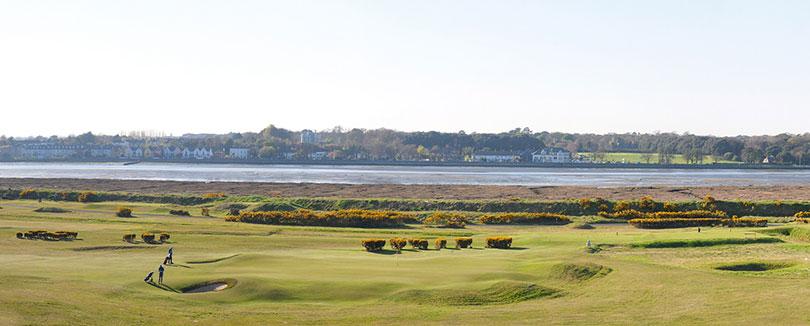
The back tees are all you would ever want at just under 7,000 yards (mortals at 6,425), the sea is present on both sides in places and the gently-flowing fairways lend themselves to a tight, ball-striker's game that I was unable to purchase at the pro shop. Like so many modest links courses – St. Andrews being the poster child – Royal Dublin does not, at first glance, look intimidating or cinematic. But with the wind a constant presence, and an accurate driver always needed, the drama builds at Royal Dublin as the subtleties of Hawtree's work reveal themselves.
The back nine is 500 yards longer than the front, and its par-fours (408, 410, 445, 435 and 440) on any normal windy day become mighty exams of your personhood. This regal club – one of the few with a driving range -- has not rested on its laurels and remains a welcoming spot just minutes from the middle of Dublin.
You may skip The K Club.
Rapaciously over-priced at nearly $300 for primetime, these two Arnold Palmer/Ed Seay, Florida-style parkland courses are owned by a billionaire who has everyone on staff call him, Doctor. For about the same money, go to Northern Ireland and play Royal County Down and Royal Portrush, consensus world top-tens that define links golf and are open to the public. If you're set on playing a marvelous parkland course, try Belvoir Park or Malone Golf Club in Belfast, Fota Island in Cork or scenic Westport, out West in County Mayo (yet another great course designed by the busy Hawtrees).
Atop my list of the best courses in Ireland that are barely known in America, would have to be County Louth Golf Club, or as it is universally known over there, Baltray.
Like its companions near Dublin, Baltray (founded 1892) could certainly act pretentious if it were just the quality of golf being judged. But this is great egalitarian golf in the friendliest of settings. Their driving range was crowded with eager juniors when I got there. The members greet you as though you once belonged. It is this Irish golf culture, more than any single collection of 18 holes, that keeps bringing me back. The teenagers I saw who just threw a bag over their shoulder and walked to the course from a nearby home haven't a clue how charmed their life seems.
But you need a solid game straight off, as a 415-yarder with the sea in the distance greets you at the first tee. Penal bunkers squeeze your drive, and the protected green will be the first of many that is so nuanced – no oceanic swells here – you'll find yourself staring at basic 8-foot putts that seem as obvious as Picasso.
Two wondrous par-threes, the 5th and 7th, both at about 155 yards, make the front nine memorable and might be the highlights of a half-dozen stellar holes at Baltray. The returning nine have a trio of par fours – 12, 13, 14 – that may well define your round, so don't get too taken with the blonde sea grasses and the alluring solitude afforded by the bulky dunes.
The nearby Seapoint Golf Club is one of the newest links in Ireland, having opened in 1993, and is more affordable (60 euros) than others, but with the length (7,000 yard tips) and challenge to have held numerous big tournaments.
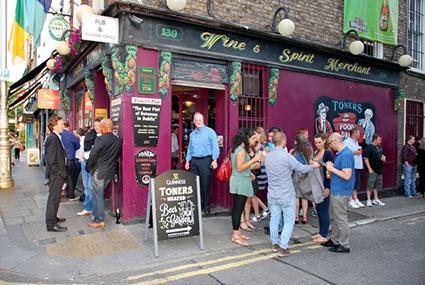
About 30 miles south of Dublin, and well worth its price tag, is The European Club, a captivating tribute to links golf designed by a jolly golf genius named Pat Ruddy.
Soon after its storied birth in the 1990s, the course won huge praise from Tiger Woods, Tom Watson and Padraig Harrington, among others, the latter using Ruddy's exacting course to practice for his two British Open victories in 2007 and 2008.
You can read more about Ruddy and his top 100 world course in this earlier column, but set aside a full day to enjoy its unrelenting challenge and perhaps a clubhouse conversation with the man who (along with his son, Gerry) designed and built the whole thing.
And a last thought about the timing of your round. Give some thought, especially in the long summers, to teeing off before 8 a.m. or after 4 p.m., so you'll have enough time to enjoy Dublin for more than just its pubs.
Related: Get the gear you need to do golf right in Ireland
-- Bruce Selcraig is a former staff writer with Sports Illustrated whose work has appeared in The New York Times Magazine, Harper's and The Atlantic, among others. Contact him at selcraig@swbell.net.


